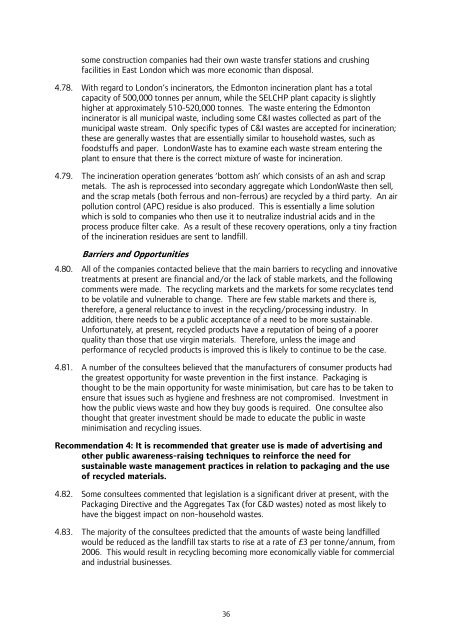London Wider Waste Strategy - London - Greater London Authority
London Wider Waste Strategy - London - Greater London Authority
London Wider Waste Strategy - London - Greater London Authority
You also want an ePaper? Increase the reach of your titles
YUMPU automatically turns print PDFs into web optimized ePapers that Google loves.
some construction companies had their own waste transfer stations and crushing<br />
facilities in East <strong>London</strong> which was more economic than disposal.<br />
4.78. With regard to <strong>London</strong>’s incinerators, the Edmonton incineration plant has a total<br />
capacity of 500,000 tonnes per annum, while the SELCHP plant capacity is slightly<br />
higher at approximately 510-520,000 tonnes. The waste entering the Edmonton<br />
incinerator is all municipal waste, including some C&I wastes collected as part of the<br />
municipal waste stream. Only specific types of C&I wastes are accepted for incineration;<br />
these are generally wastes that are essentially similar to household wastes, such as<br />
foodstuffs and paper. <strong>London</strong><strong>Waste</strong> has to examine each waste stream entering the<br />
plant to ensure that there is the correct mixture of waste for incineration.<br />
4.79. The incineration operation generates ‘bottom ash’ which consists of an ash and scrap<br />
metals. The ash is reprocessed into secondary aggregate which <strong>London</strong><strong>Waste</strong> then sell,<br />
and the scrap metals (both ferrous and non-ferrous) are recycled by a third party. An air<br />
pollution control (APC) residue is also produced. This is essentially a lime solution<br />
which is sold to companies who then use it to neutralize industrial acids and in the<br />
process produce filter cake. As a result of these recovery operations, only a tiny fraction<br />
of the incineration residues are sent to landfill.<br />
Barriers and Opportunities<br />
4.80. All of the companies contacted believe that the main barriers to recycling and innovative<br />
treatments at present are financial and/or the lack of stable markets, and the following<br />
comments were made. The recycling markets and the markets for some recyclates tend<br />
to be volatile and vulnerable to change. There are few stable markets and there is,<br />
therefore, a general reluctance to invest in the recycling/processing industry. In<br />
addition, there needs to be a public acceptance of a need to be more sustainable.<br />
Unfortunately, at present, recycled products have a reputation of being of a poorer<br />
quality than those that use virgin materials. Therefore, unless the image and<br />
performance of recycled products is improved this is likely to continue to be the case.<br />
4.81. A number of the consultees believed that the manufacturers of consumer products had<br />
the greatest opportunity for waste prevention in the first instance. Packaging is<br />
thought to be the main opportunity for waste minimisation, but care has to be taken to<br />
ensure that issues such as hygiene and freshness are not compromised. Investment in<br />
how the public views waste and how they buy goods is required. One consultee also<br />
thought that greater investment should be made to educate the public in waste<br />
minimisation and recycling issues.<br />
Recommendation 4: It is recommended that greater use is made of advertising and<br />
other public awareness-raising techniques to reinforce the need for<br />
sustainable waste management practices in relation to packaging and the use<br />
of recycled materials.<br />
4.82. Some consultees commented that legislation is a significant driver at present, with the<br />
Packaging Directive and the Aggregates Tax (for C&D wastes) noted as most likely to<br />
have the biggest impact on non-household wastes.<br />
4.83. The majority of the consultees predicted that the amounts of waste being landfilled<br />
would be reduced as the landfill tax starts to rise at a rate of £3 per tonne/annum, from<br />
2006. This would result in recycling becoming more economically viable for commercial<br />
and industrial businesses.<br />
36
















